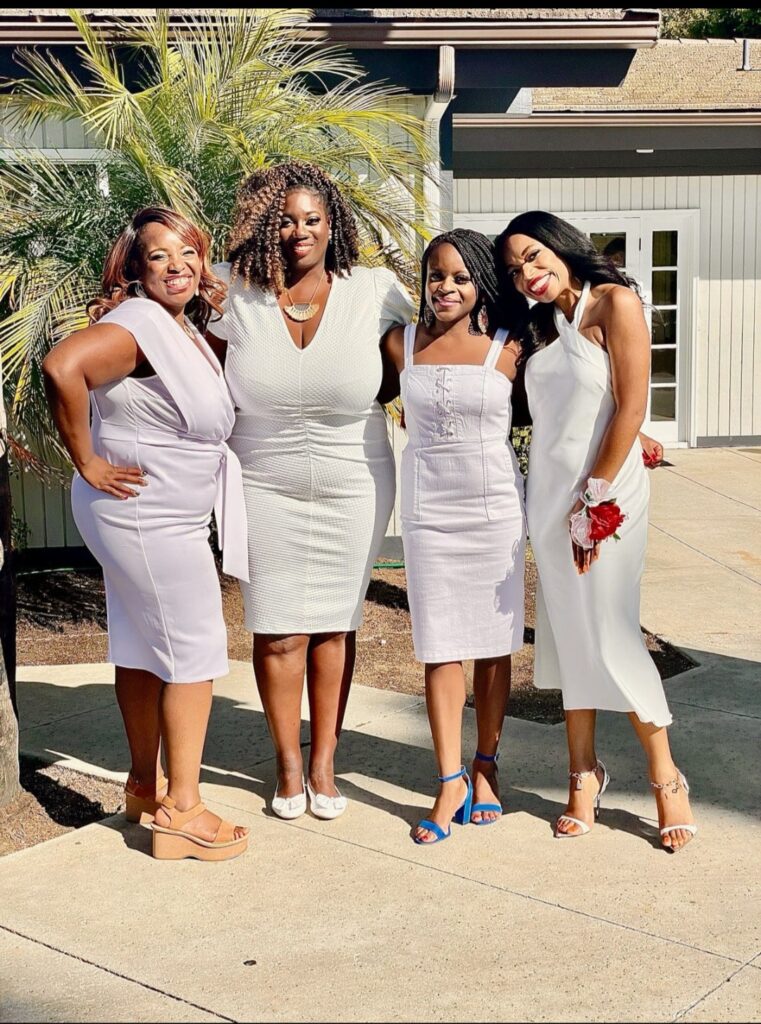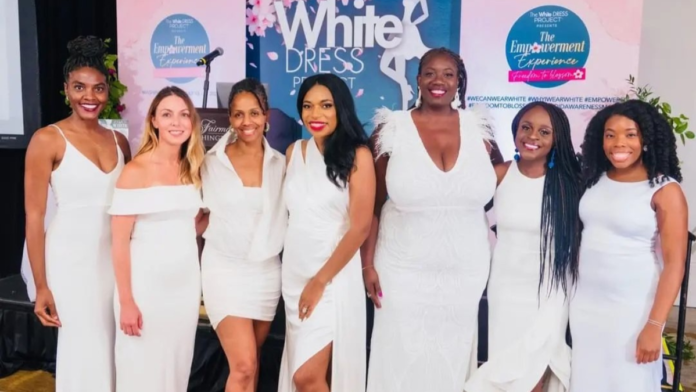( ENSPIRE She Did That ) The White Dress Project Founder Tanika Gray Valbrun Advocates for Women’s Fibroid Awareness
ENSPIRE Contributor: Gabrielle Maya
Tanika Gray Valbrun advocates for women’s reproductive health, and the fibroids awareness initiative created The White Dress Project. Her fibroid journey consisted of surgery to remove 27 fibroids, which led to her mission of advocacy. She has collaborated with doctors, health advocates, and elected officials nationwide. She has successfully advocated for the legislation. This is designated July as “Fibroids Awareness Month.” Valbrun’s goal is to empower and support women facing similar struggles. For 2024, The White Dress Project plans to celebrate its past decade of raising awareness on all reproductive health.
The White Dress Project is a nonprofit organization created in July 2014. It is dedicated to raising global awareness about the uterine fibroid epidemic. Through education, research, community, and advocacy, Valbrun is setting the stage for a conversation on fibroids. From educating the public about treatment options to building a supportive community, women no longer have to suffer in silence from fibroids.

The EmPOWERment Experience is an annual event held July 11 to 13, 2024, in Washington, D.C. It focuses on empowering women and raising funds and awareness about uterine fibroids. According to the National Library of Medicine, fibroids impact more than 70% of women, and for Black women, this increases to 90% by age 50. With 60% affected between ages 35 and 40, the theme for this year’s event is Igniting Change: stories that sparked a movement.
Valbrun shares with us her fibroid experience and how it led to creating The White Dress Project. Also, she discusses how the project was accomplished in the last decade, which inspired this year’s theme of igniting change. Next, she explores strategies to decrease fibroids, workshops, and activities to educate and research reproductive health.
What were your thoughts after your fibroid surgery? What were some questions you asked yourself that led to creating The White Dress Project?
I was nervous and confused and didn’t understand why this was my journey. When starting The White Dress Project, I wanted to understand this condition I was experiencing.
So many questions led to the creation of The White Dress Project. Why weren’t more people talking about fibroids publicly? Why is there seemingly minimal research funding for this condition? Why were so many people suffering without public awareness campaigns or outward cries of stories and efforts toward advocacy? Why were so many people undergoing hysterectomies that were not medically necessary? How could I use my personal story to create community and impact change?
What are some of the many accomplishments that The White Dress Project achieved over the last decade?
I’m proud to say that The White Dress Project has accomplished many things over the last ten years. Firstly, the community and support we’ve built nationally and globally is beyond amazing. This community consists of over 70,000 supporters on social media, uniting health practitioners, corporations, media moguls, educational institutions, advocacy groups, legislators, and, most importantly, patient advocates worldwide. Without it, we could not have empowered thousands of individuals to tell their reproductive health stories with conviction, power, and undeniable passion.
We’ve helped shape the conversation around fibroids and women’s reproductive health, leading to increased awareness and research. Our work has garnered national attention, including July being recognized as “Fibroids Awareness Month” and numerous media appearances. Our national and international surveys drew thousands of participants, and our groundbreaking research will be published in a peer-reviewed paper.
Furthermore, we were also recognized by the American Society for Reproductive Medicine, earning a coveted presenter slot at their 2024 annual conference. We also participated in the historic signing of President and Dr. Biden’s Women’s Health Research Initiative.
Moreover, we’re also proud to say that we’ve collaborated with esteemed institutions on significant achievements, including Morehouse School of Medicine on a women’s health mobile unit. Moreover, Spelman College adopted our healthcare advocacy curriculum for pre-med students. It secured a $7.8 million NIH grant with the University of Michigan for the PEACE initiative to eliminate disparities in the fibroid experience.
What inspired the 2024 theme ‘Igniting Change’ for The EmPOWERment Experience?
The White Dress Program Programming committee led by Jonelle Henry was highly intentional about our 10th-anniversary theme. We needed to ensure that every attendee felt empowered to take action for their situation. The theme reflected a desire to move beyond empowerment and focus on taking concrete steps to create positive change.
What iconic workshops and activities can attendees expect throughout those three days, and what overall impact do you hope they will have on the cause of fibroid awareness?
We touched on the five senses of the journey of life with fibroids. What do you hear and see as physical symptoms? How do you feel about emotional symptoms and their impact on your emotional health, career, and relationships? Are there foods associated with fibroids, and how does your overall diet play a role? Most importantly, we delve into the sense of community and its profound impact on anyone living with fibroids.

According to the National Library of Medicine, fibroids impact more than 70% of women and increase by 90% for Black women. What are some strategies for decreasing those percentages, and how has The White Dress Project accomplished that?
Unfortunately, there aren’t any proven strategies to prevent fibroids directly. The exact cause of fibroids is still unknown, although research suggests factors like genetics, lack of effective amounts of Vitamin D, and hormone levels may play a role.
Additionally, The White Dress Project explicitly tackles these issues by educating women about fibroids, including their prevalence and symptoms. This empowers women to seek medical attention and discuss their concerns. We foster a supportive network for women with fibroids. Sharing experiences and knowledge can help women feel less alone and navigate treatment options.
We lobby for increased research funding dedicated to fibroids, namely the Stephanie Tubbs Jones Fibroid Research and Education Act introduced by Congresswoman Yvette Clarke and the U-Fight Bill introduced by Congresswoman Shontel Brown. These legislations will lead to a deeper understanding of the condition through dedicated funding and research and potentially pave the way for prevention strategies in the future.
Please share your experience with fibroids. What are some things many people don’t know about fibroids, and what is the importance of raising awareness, supporting them, and researching the cause?
I have had three myomectomies. During my first myomectomy, I had 27 fibroids removed, and I think people often underestimate three things when it comes to dealing with fibroids:
- Prevalence: While often discussed as a condition affecting Black women more significantly (with a 90% increased risk, as you mentioned), fibroids are incredibly common overall, impacting over 70% of women at some point by the time they are 50.
- Varied Symptoms: Symptoms can range widely, with some women experiencing none. They can include heavy bleeding, pelvic pain, frequent urination, and difficulty getting pregnant.
- Emotional Impact: The unpredictable and sometimes debilitating nature of fibroids can significantly affect a woman’s quality of life and emotional well-being.
Our work at TWDP is essential because many women feel alone or dismissed when dealing with fibroids. Our support helps women understand their bodies and advocate for themselves, providing them with knowledge of minimally invasive treatment options and discussing the root cause, which paves the way for preventative measures and management.
Here is a quick event recap for The White Dress Project from July 11th to July 13th. Some of the key highlights of this three-day experience were a film screening of “Me Period!” accompanied by a talk and a provoking conversation exploring menstruation. Followed by the latest discussion and research on fibroids through John Hopkins University. A debate on managing intimacies with those who have fibroids. Some R&R activities with their mixology and flower arrangement workshop to decompress. An informative dialogue with doctors about reproductive health.
Next, a conversation for advocacy through the In White Together event, an influential luncheon where allies and advocates speakers brought up ways to increase support for those with fibroids. Along with fundraising activities and awards. It ended on a high note with Tori Dixon, a licensed professional counselor working with Black and Brown women experiencing symptomatic fibroids, presenting at the Night in White Blossom Awards & Fundraising Gala.

Valbrun states, “Over the past decade, we’ve made remarkable progress and significantly raised awareness about the profound impact uterine fibroids can have on the quality of life and health.” In addition, she states, “We’ve revolutionized storytelling and empowered countless individuals to share their stories confidently. However, our work has just begun. Too many women still suffer in silence, and we are dedicated to changing that.” Follow Tanika Gray Valbrun on Instagram for more details on events and reproductive health and fibroid awareness discussions. View details and registration here for more information on The White Dress Project.
Related Articles: The White Dress Project Hosted Weekend for Fibroid Awareness, Fibroid Fighters Foundation Works to Spread Awareness About Uterine Fibroids






